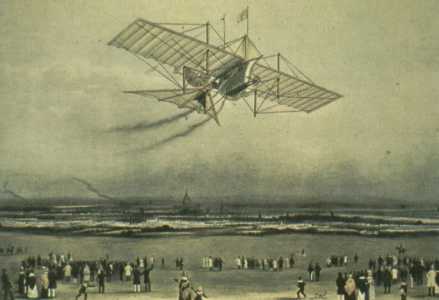|
Henson and Stringfellow: The Dream Takes
Shape
Born in 18 12,William Samuel Henson was, like
his father, a successful
industrialist in the lacemaking
business in Somerset, England. In 1840, under the influence
of Cayley’s early writings,
Henson and an engineer who also
worked in the lacemaking industry, John
Stringfellow, designed a
steam-driven airplane they called
an “aerial steam carriage.”
There were many
elements of the design of
the Ariel (as Henson called it) that proved
to be prophetic of later
aircraft, and a simple glance at
the design makes one feel as if one is looking at a cartoon
prototype of the modern airliner.
In fact, Henson and Stringfellow planned to create an
international airline, the Aerial Transit Company,
and proceeded to raise investment
capital. They embarked on
a massive publicity campaign that involved
illustrations of the Ariel in
flight over London and exotic
settings in Egypt, India, and
China.
They hoped that the illustrations would
make people believe the aircraft was an
established fact. These illustrations appeared in
newspapers, magazines, on handkerchiefs, trays, wall
tapestries, and lace-frilled
placemats. The public was caught
unprepared for this barrage, and instead of taking to the
idea, investors who
might have supported it withdrew.
Henson then appealed to George Cayley, who declined
to invest (or even to
endorse the idea until they built a
working model of the Ariel).

Visionary designs
of the nineteenth century:
Henson’s Aerial Steam
Carriage
The pair built a
model in 1847, but the steam engine
Stringfellow had designed was simply not powerful enough.
Finally, Henson abandoned the entire project and emigrated
to the United States, but Stringfellow stayed on and in 1848
tried once more to fly a model with an improved steam
engine. The results were disappointing—nothing more than a
short, uncontrolled hop.
At this point, Stringfellow also
gave up, and the entire episode was forgotten. But the Ariel
did have some positive effects: its design prompted Cayley
to rethink wing configuration and come up with the
multiple-wing design, a feature of nearly all the early
successful aircraft. The plane itself was logically designed
and inspired many later builders. In spite of the scorn
heaped on Henson and Stringfellow’s outrageous publicity,
the many illustrations that found their way all over the
world placed the issue of aviation and the possibility of
comfortable flight to faraway places squarely before the
popular consciousness.
|
